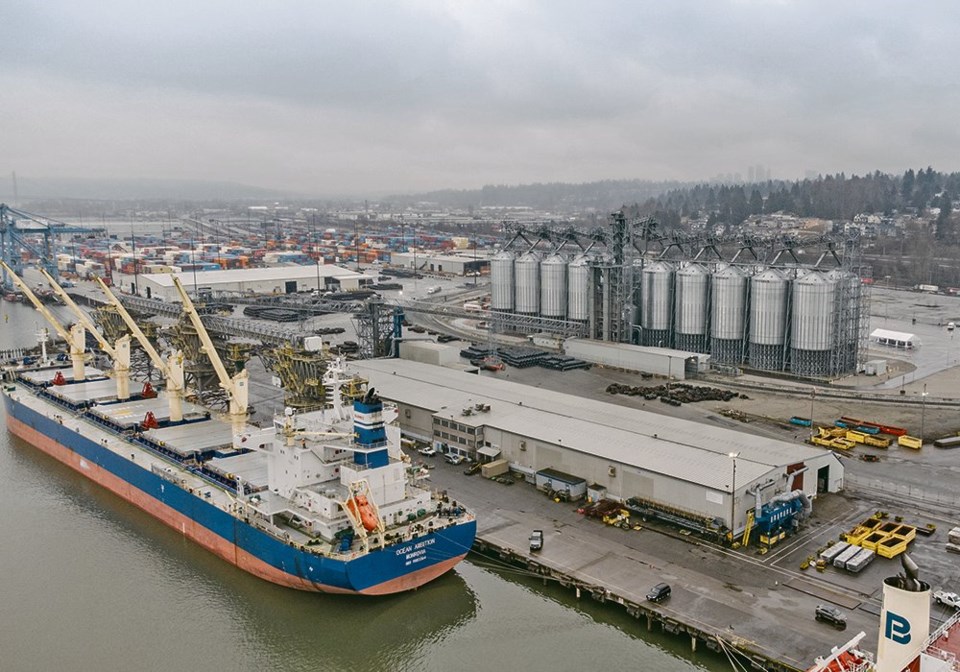WESTERN PRODUCER — Canada’s newest West Coast grain export terminal is now fully operational.
Earlier this month, the Fraser Grain Terminal (FGT) in Surrey, B.C., held an official grand opening to mark completion of the new multi-modal loading facility.
Located on the Fraser River, the terminal can load ocean vessels, trucks and containers and will add four to 4.5 million tonnes of annual West Coast export capacity to the country’s commercial grain handling industry.
The terminal has on-site storage of 74,000 tonnes, including 20 3,500-tonne steel storage bins and six 500-tonne bins for on-site container loading.
The single-berth terminal can accommodate Panamax-sized vessels although Panamax ships would not be fully loaded at the facility due to an 11.5 metre draft restriction on the Fraser River.
For a full load, Panamax-sized vessels would need to be topped up at other deep-water facilities.
Maximum shiploading capacities at FGT are estimated at roughly 2,000 tonnes an hour using a three-spout loading system. Rail car unloading is facilitated by a loop-track, 200-tonne per hour system.
FGT is a 50-50 joint venture involving project partners Parrish and Heimbecker Ltd. (P&H) and Grains Â鶹´«Ã½ Canada.
“The Fraser Grain Terminal is an excellent example of an infrastructure project that supports Canadian farmers, increases efficiency in grain exports and builds strong business relationships with customers around the world,” said Warren Stow, president of GrainsÂ鶹´«Ã½ Canada.
“Along with our partner P&H, we are proud of the project’s completion and excited for its full operation.”
In a March 15 interview with The Western Producer, Stow said the facility’s location on the Fraser River offers unobstructed train access and avoids the need to move large grain trains through congested railway corridors that service the north and south shores of the Vancouver harbour.
The FGT facility is serviced by Canadian National Railway and is located roughly eight kilometres from CN’s Thornton Yard, an important rail traffic hub also based in Surrey.
“We’re seeing (car) turn-around times in the seven- to eight-day range, up-country Saskatchewan to up-country Saskatchewan,” Stow said.
“That’s three days out, one or two days to unload (at FGT), and then three days back to the Prairies,” he added.
“All of our (GrainsÂ鶹´«Ã½ Canada) facilities are on CN lines and the majority of P&H’s facilities are on CN as well. … There’s no bridges, no overland crossings and no tunnels, so it’s just a straight shot and it’s only a few kilometres from CN’s Thornton Yard so service is really good.”
In addition to rapid turn-around times at FGT, the GrainsÂ鶹´«Ã½ country elevator network is serviced by dedicated high-capacity grain trains that eliminate the need for shunting or reconfiguring trainloads.
“When you have those bigger capacity cars, loop-track facilities, an unobstructed railway corridor and now a super-efficient export terminal, it makes for a pretty compelling supply chain,” Stow said.
In a joint news release, P&H and GrainsÂ鶹´«Ã½ Canada said exports of Canadian grain and specialty crops to growing markets in the Asia Pacific region continue to increase.
Annual export capacity at the facility, including approximately 500,000 tonnes of containerized grain and 3.5 to four million tonnes of bulk commodities, will be split equally between P&H and GrainsÂ鶹´«Ã½.
“This grain terminal is one of a continuing series of large-scale investments in agriculture across Canada to help link producers to value-added businesses and end-use customers in the most efficient way possible,” said John Heimbecker, chief executive officer of P&H.
Stow said P&H and GrainsÂ鶹´«Ã½ anticipate using the facility’s entire export shipping capacity for grain originated at their own collection facilities across the Prairies.
Export capacity afforded by FGT might allow GrainsÂ鶹´«Ã½ to expand its country elevator network, although no commitments have been made to date, Stow added.
GrainsÂ鶹´«Ã½’s country elevator network consists of high-throughput, loop-track facilities at Reford, Sask., Maymont, Sask., Vegreville, Alta., and Huxley, Alta.
“Both P&H and GrainsÂ鶹´«Ã½ Canada have every intention to fill that capacity at two million tonnes (annually) for each shareholder, so that would be our expectation,” Stow said.
“We’ve got to prove the volumes at FGT, but at that point, we feel that with our four country elevators, we (GrainsÂ鶹´«Ã½) will get somewhere in the neighbourhod of 1.5 million tonnes of origination, which would leave us the opportunity to buy grain from others, or to do something further on origination.”

